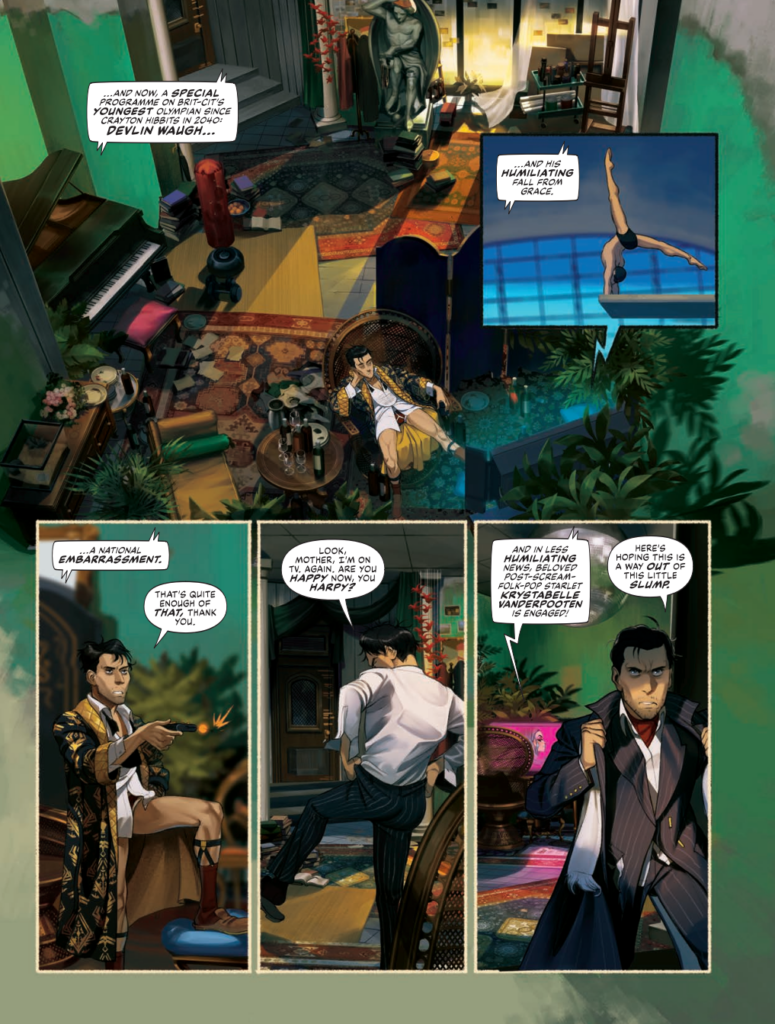Mega-City Max Interviews: Oliver Gerlach & VV Glass on Devlin Waugh – Maxing out Brit-Cit’s most fabulous man!
20th July 2023
Mega-City Max is a brand-new comic special set deep in the world of Dredd, but coming at you with a distinctly different look at the world with the stories featuring teen- and post-teen versions of classic 2000 AD characters.
Aimed at teenagers, this stand-alone special is fast-paced and action-packed, and features the hottest breaking talent in comics. It’s Mega-City to the Max – it’s Mega-City Max!
Today we’re chatting with Oliver Gerlach & VV Glass, two exciting creators who’ve brought a young Devlin Waugh to life, Mega-City Max style!
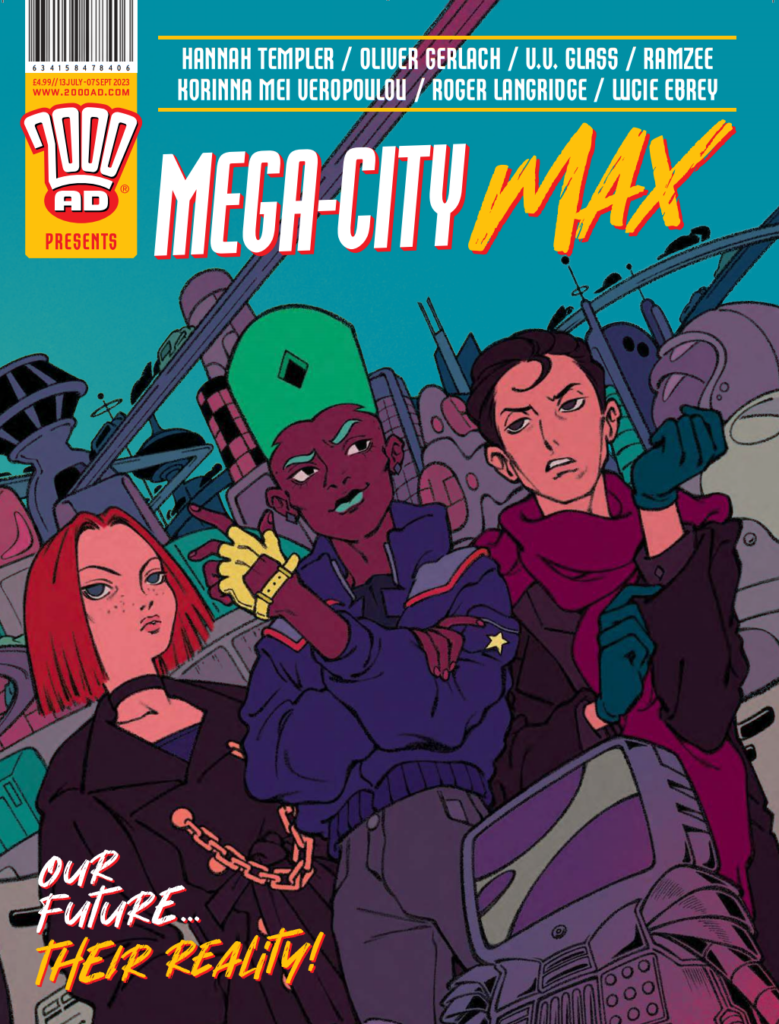
Mega City Max is packed with five brand-new strips featuring some familiar names but rejuvenated and made fresh and new by some of the best new talent in comics. You’ll see a just kicked out of the Justice Department Galen DeMarco starting off as a P.I., Walter the Wobot getting into stand-up comedy, the Harlem Heroes taking on the Venetian Vipers in the Aeroball Mega-City Cup, and take a look at the dumbest fads hitting MC-1 in Cranium Chaos.
But here we’re going to chat to Oliver Gerlach and VV Glass about bringing us Brit-Cit’s most notorious man, Devlin Waugh, in Wedding Hells!
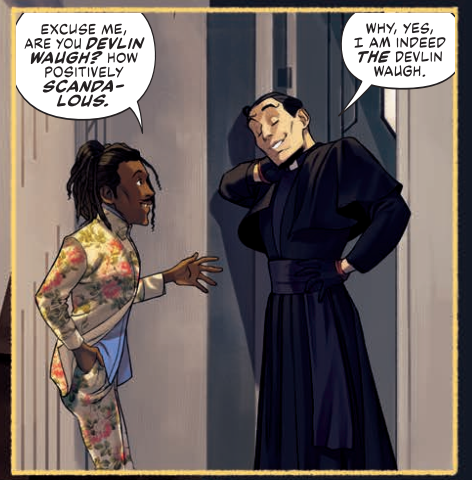
Oliver, V, welcome! So good to read your Devlin Waugh strip in Mega-City Max! We’ll get to him in just a moment, but first – what does it mean to you to be here at the launch of a new 2000 AD comic? (Okay, okay, it’s only a Special right now, but we have hope, right?)
OLIVER GERLACH: This is the first time I’ve written for 2000 AD and being in on the launch of a new comic, with the characters and universe that I’ve grown up loving, feels like a really special opportunity. It’s a chance to help shape something fresh and exciting, while still being an opportunity to play with the old toys.
And let me tell you, getting to write the classic 2000 AD fake swears into a script made me grin like a complete idiot.
VV GLASS: I worked on a few Rebellion anthologies before – a bit of the regular issues, a bit of the Tammy & Jinty and the Misty specials, but this is the first that’s its own distinct property, and the first to be a reimagining of existing concepts rather than a continuation of them.
It’s weird (good) being at the origin point of something without knowing where it’s going to go – you never know, in another 45 years people might be looking back at this issue as the start of something big.
Oh, absolutely V – and following on from that, what are your hopes for the future of Mega-City Max and would you return?
VVG: I really hope it carries on, it’s got a lot of potential as something playing with & speaking back to the years of material we have. And I’d like to see this and Regened keep going as a general thing; not just reimagining existing characters, but giving us storylines about Mega-City teenagers/kids, even if that needs to be separate from the usual output. Dredd (etc.) strips stick to adult casts for obvious reasons, but there’s a lot you can do with everyone else who exists in that world. Youth culture in the technofash future must be absolutely off the wall.
And returning? Of course! Wild horses etc.
OG: I really hope this has a future – as a reader, I want to see other characters reimagined like this. 2000 AD has such a huge stable of characters who could be great fun in this context. Give me a teen Nikolai Dante!
I’d return in a heartbeat. Honestly, it’s only the fact that I don’t live anywhere near the 2000 AD offices that’s stopping me from camping outside the door until they let me back in. I’ve had so much fun working on this, and I’d kill to do it again.
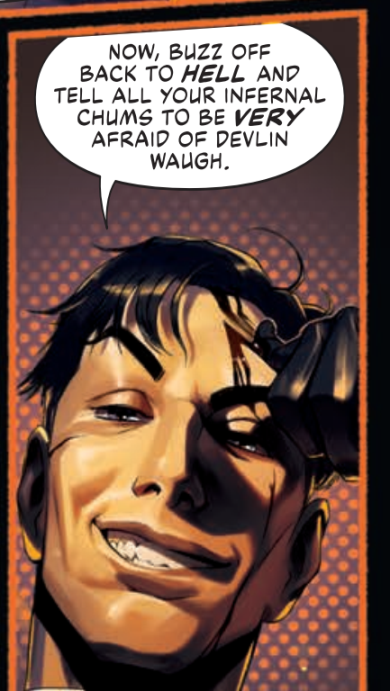
When it comes to Mega-City Max, the whole idea behind it is to broaden the readership, aiming for a slightly older readership than Regened, the troublesome teen market. What are your general thoughts on the idea and the concept?
OG: Generally, I think it’s a great idea. Comics need to draw in new readers and change with the times, or the audience only ever gets smaller as people gradually lose interest, and that’s bad for everyone.
In this particular case, though, I think it’s more actively exciting than a ‘do this or die’ situation. Mega-City Max is proving that the worlds of 2000 AD don’t have to be one thing – that it can be anything, as long as it’s got the right fire and energy behind it.
If you look at the history of 2000 AD, it’s been so many things, there have been so many series with so many tones over the last 40 years, and so many of the best of them have been the ones that try to tread new ground and be fresh and exciting. Even just within Dredd, Ezquerra’s Dredd isn’t McMahon’s Dredd, which isn’t Flint’s Dredd. And isn’t that more exciting? 40 years of trying new things is how you get new hits and new favourites.
VVG: The style and tone of 2000 AD has been so varied over the years that something like MCM fits pretty naturally in the pantheon. We have 2000 AD for the established adult fanbase, and 2000 AD Regened for younger people, so why not try reaching out to teenagers with a 2000 AD that speaks to them too?
It’s good to test new ground when the opportunity comes up – it’s the thing that’s kept 2000 AD going for as long as it has. Diversification doesn’t mean dilution, it means adding an extra branch to a massive already well-branched tree. And there’s that possibility that MCM will be a gateway read for people who would normally never touch this material, who can then follow up by getting into the main Prog too.
OG: This is more 2000 AD stuff, for more people, not replacing anything. And that’s something everyone should be excited about.
How can more 2000 AD ever be a bad thing?
Have you seen the finished comic yet and what do you think of the talent and the strips in it?
OG: I’ve read the PDF of our Devlin Waugh story, but I’ve not actually seen the rest of the issue yet. I’m eagerly waiting by my letterbox every morning in the hopes that it’ll arrive! But we’ve got an amazing line-up here – Roger [Langridge] is always an absolute treat to read, of course, and what I’ve seen from everyone else looks really fun. I’m very excited to get my hands on the whole thing as a reader!
VVG: I’ve seen it about 75% done, but not lettered & graphicked. I’m always surprised by how much more of a ‘real thing’ that step makes it all look, the design/layout people really are the unsung miners in the shaft. So to speak. Judging from the preview pages of the other strips I’ve seen, it’s going to be a great comic!
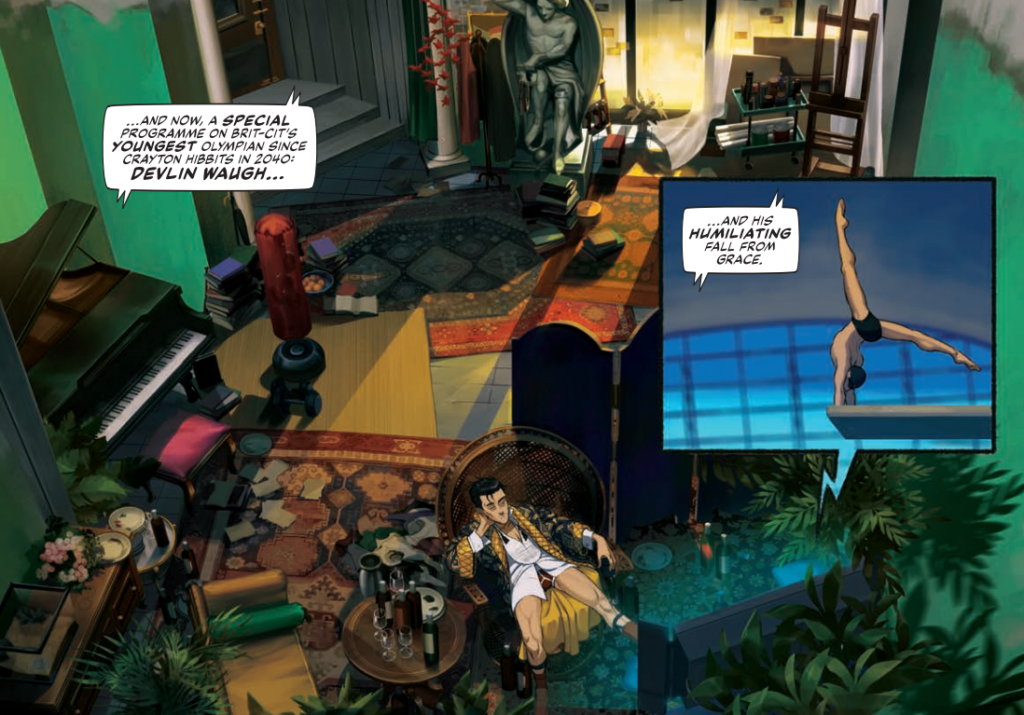
Okay then, let’s talk Devlin!
Your Devlin Waugh strip, Wedding Hells has a young Devlin as a Brit-Cit born Olympian fallen on hard times. He’s, to use his own words ‘Olympic hero, wedding officiant, part-time occultist, dashing rogue.’ But it all opens with a very miserable Devlin, surrounded by luxury and wonder – not to mention dressed in dress shirt, smoking jacket, and Y-fronts – such a great opening image.
So, what’s Wedding Hells all about?
OG: At heart, Wedding Hells is about looking at your life and wondering if you’ve peaked too young. It’s about hitting a massive slump relatively early on, and trying to work out how to dig yourself out of that hole. It’s also about demons, yelling, and camp.
VVG: Oliver would know since he, you know, wrote it, but as a reader (technically) I’d say it’s also about celebrity, what people in that world will do to maintain the spotlight, and in that vein the kinds of personalities that want to stay in said spotlight.
Devlin, of course, is one hugely popular character in the Megazine. But your brief was to write and draw a teen Devlin, bringing him to a new, possibly unfamiliar audience. How did you even begin?
VVG: The main thing was keeping the core appeal of the character while showing what he’d be like as a youngo, without straying too much from the existing blueprint.
He’s the same guy, but with a less evolved version of the style he has in the original stories, to go with his less evolved sense of himself. I think his major charm points click with readers regardless of age, so it was a case of boiling everything down to those. The Waughdrobe was perfect so we kept that, but made his aesthetic slightly the worse for wear, since Devlin’s more down on his luck and less put together than he is in his moustache era. I kind of wish I’d kept the Terry-Thomas tooth gap now, though.
OG: For me, the start point was in working out how to thread that needle of ‘fresh new introduction’ and ’old favourite character’. It’s an intimidating brief, being handed a popular character and asked to do a new take on him that’s accessible to a new audience, without losing sight of what makes Devlin Devlin.
So that meant looking at how he’s been presented before, and working out what’s a completely immutable fact about him and what’s maybe something he might not have properly developed until later life.
We’ve seen a lot of Devlin’s life over the years, from his childhood to his current adventures in the Megazine. But there’s a big gap from around the age of 14 to when we first meet the original Smith/Phillips version. So that gave us a few years in which to play with him, and specifically a few years that are a life stage when people are trying to work out who they are. So how does Devlin Waugh work out who he is?
Finding an insecurity to build the story around gave a great starting point, and from there the character just kind of took over and wrote his own story.
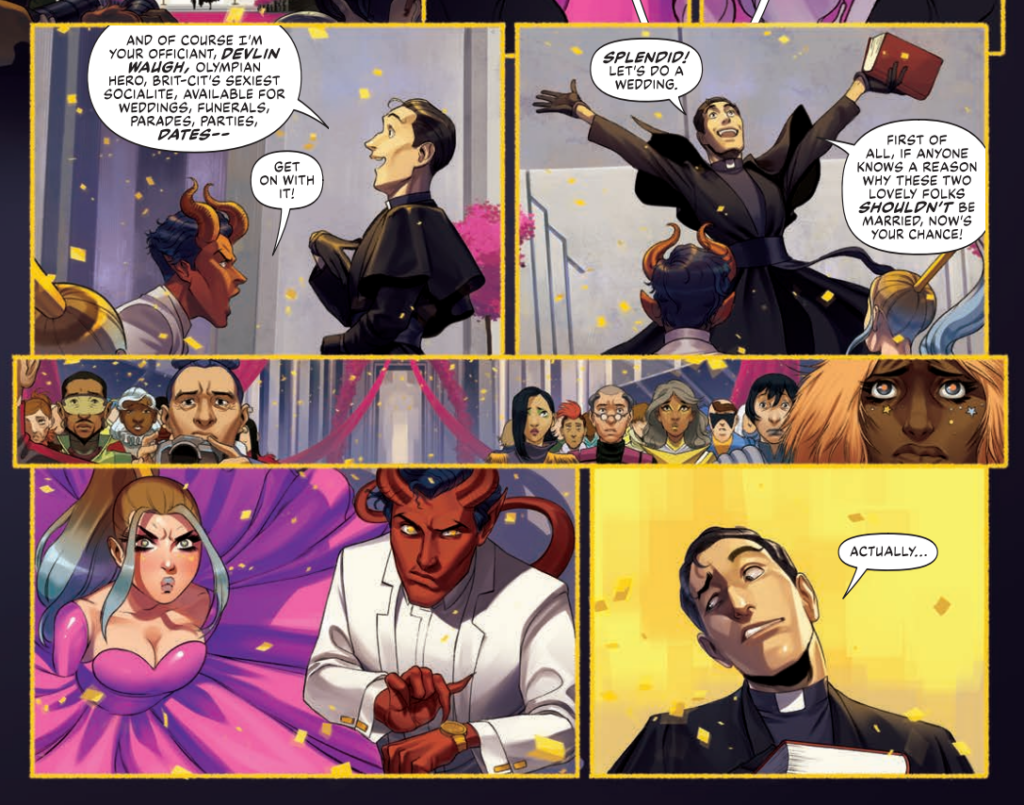
There’s no moustache there (yet) but all the elements of Devlin are in your tale, flamboyantly gay and absolutely in love with himself, ego personified. Sure, a bit less sure of himself and, when we meet him, feeling all washed-up.
There’s a lush look to it all – V has done an amazing thing here. The backgrounds are beautiful, but the figure work seems really fresh, popping from the page. And when it’s called for there’s a great sense of movement to it all. Very much of the now, manga-influenced it seems, but with a fabulous style all its own.
Oliver – what do you think of what VV’s done with your script?
OG: V’s astonishing. Just, absolutely mind blowing stuff. There’s so much elegance and charm to their work, but their facial expressions are so constantly funny. When I saw the unlettered version of the art I was laughing out loud at all of the panels that would eventually have my favourite bits of dialogue on, which is generally a good sign.
And just look at the backgrounds! VV’s drawn in so much detail with all the background posters and details, and there are incredible jokes hidden in there that were a complete surprise to me. The whole experience has been a joy, and they’ve done genuinely amazing work with the story. I’m delighted.
And VV, what sort of look were you going for here with Devlin? What sort of influences were you bringing to it? I understand Oliver Pickles [the MCM editor] suggested that you use the illustrations of Antonio Lopez, the fabulous queer fashion designer, as a springboard for your Devlin?
VVG: Fashion illustration of the 80s mostly – yes, Antonio Lopez, who has a very specific look for his male models that seemed perfect for a younger Devlin. It really captures the combo of henchness and elegance that Devlin’s always had, without being as focussed on beef as the Tom of Finland original.
He’s sort of a mishmash of period models and 20th century dandies, and a bit of Hirohiko Araki, which is pretty much the same as saying ‘fashion illustrations of the 80s’.
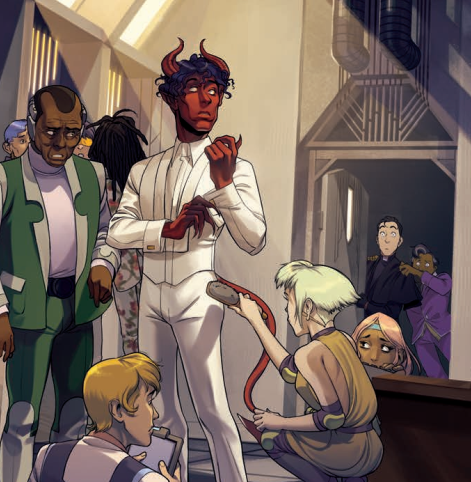
Were you both familiar with Devlin before the strip or was there a lot of required (and enjoyable) reading to be done for this one?
VVG: I wasn’t! Devlin hasn’t penetrated the zeitgeist in the same way as his Megapeers for whatever reason. I didn’t have as much background reading to do as Oliver, since Devlin looks pretty much the same in all his stories, give or take a few Schwarzeneggers.
I looked at a lot of Charlie Adlard’s work on Armitage though, to get an idea of the Brit-Cit Devlin exists in, so the setting could reflect the character and vice-versa. And Adlard’s painted work on that series had a lot of influence on the palettes I ended up using as well.
OG: I wasn’t familiar with Devlin before being offered this story. I was vaguely aware of the name, but that was about it. So when I was told the rough brief for the character, I jumped at the opportunity and then had to ask for recommended reading.
I was sent – I think most of the major John Smith stories? And I read them all in one sitting and asked for more. So then I read all of Ales Kot’s current work. And then I went and bought the collected versions of all the other stories, because I was having so much fun. So now I think I’ve read every single Devlin Waugh story up until pretty recently, and I’ve got a new favourite character. Sometimes, doing research can be fun.
What is it, do you think, about the character for you that just really seems to stick with so many creators and readers?
OG: I think Devlin’s stuck with people because Smith and Phillips introduced him with such a strong sense of character. That design, that voice, that face – they’re all immediately engaging, and for readers, there’s pretty much limitless potential. I mean, he’s essentially a comedy protagonist in a horror story, and that’s a combination that everyone loves.
As a writer, I found Devlin an absolute joy to write. He’s got such a strong voice, and once you get into it, the dialogue just flows. I’ve written licensed characters before – I wrote a Red Sonja story a couple of years ago – and Devlin just walked into my head in a way that I’ve never experienced before. He’s a real force of nature, and a constantly enjoyable character to write.
VVG: I think there’s a disjunction between Devlin as a character and the stories & worlds he moves through that’s inherently appealing.
He’s a comedy exorcist who looks like a fireman calendar and behaves like Noel Coward, but who exists in a dystopian future full of occult horrors and also some more mundane horrors. He should be a grizzled cynical Constantine type, but he’s out there having fun with it, which in turn is fun to produce and to read.
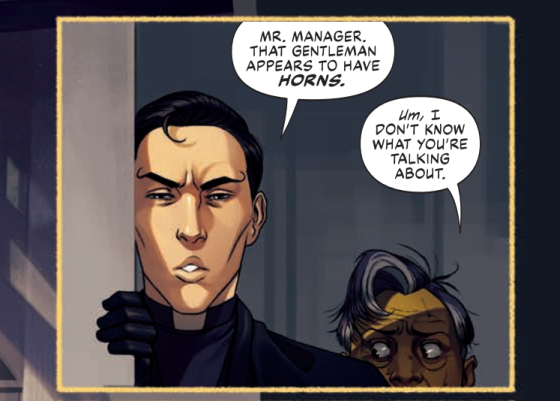
Wedding Hells really is a great intro to the character, a different but familiar Devlin, and one that I know I want to read more of.
For a start, you dangled that Olympic failure and national embarrassment in front of us but never elaborated! But he really does seem to work as Young Devlin, a great intro to the whole body of work, not to mention a fascinating (and fabulous, of course) character in his own right.
OG: Oh, I know exactly what that particular embarrassment was – if you look at his previous appearances, you should hopefully be able to join the dots on that one. It’s there in the earlier stories.
Have you both already got plans for the next episode of this particular dandy?
OG: I have a lot of stories I want to tell with Devlin. There are so many questions to explore, and so many areas of his life I want to touch on. How did he end up working for the Vatican? How did he manage to pull himself out of the slump he’s in in our story here?
I don’t want to write an origin story for the moustache, but other than that, pretty much every question you might have is something I want to touch on.
One of the things I love the most about John Smith’s writing is the way that he constantly implies the existence of previous adventures that he has no intent of ever actually explaining. I don’t want to step on his toes there – that vague texture is a great feature of Devlin’s life – but I would very much like to add to the long list of bizarre adventures and old dead friends.
So yes, that’s all a very long way of saying: I’ve got a notes file on my phone that’s been slowly filling up with one-line pitches for more Devlin stories for about a year now. If 2000 AD will have me back, I’d love to tell some of those stories.
VVG: I’m hoping Devlin is moving towards his date with the Pope, I’d love to design whatever Vatican City’s become in this reality.
Oh, that we would love to see!
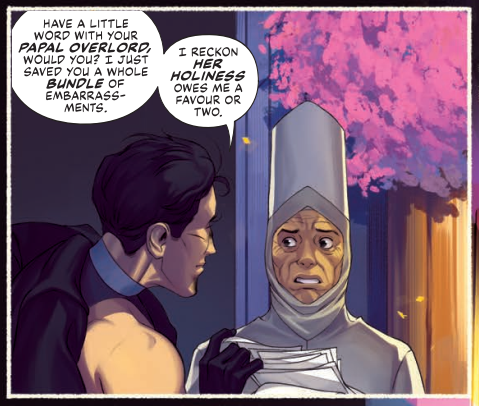
Okay then, let’s get a little bit about your good selves in here.
Oliver, you’ve been writing comics for a while now, mostly short-form works, with a specialism in queer comics for the young adult market. What sort of things should we be looking at?
OG: If you’ve not read the GLAAD award winning Young Men in Love, from A Wave Blue World, I think that’s the piece I’m proudest of. That was an anthology of queer male romance stories, all from creative teams of queer men and non-binary people. The vast majority of successful queer M/M romance is written by non-male writers, and it was an amazing experience to be part of a project to let us tell our own stories a little. Editors Joe Glass and Matt Miner put together something really special there, and brought out the best in all of our work.
There’s also first full-length graphic novel, Soup, with Kelsi Jo Silva, coming out in 2024. What’s that all about?
OG: Soup is a book born from my experiences working in restaurant kitchens. It’s a fantasy graphic novel about a girl raised in a kitchen, who starts to realise that maybe the industry that’s raised her might be a bit corrupt and abusive. She sets out to take down her boss and bring back the fun in cooking. It’s warm, fun, and deals with some serious real world issues, in a setting where Kelsi gets to draw the most delightful goblins I’ve ever seen.
How did you get into writing comics?
OG: I think I’ve always written, but it took a long time for me to start taking that seriously. I fell into academia pretty hard – I have a doctorate in Ancient Greek epic poetry, for my sins – and needed something to distract myself from that. So I started writing more fiction for fun, and then things started to snowball a bit. It turns out that when you spend all your time thinking about storytelling for academic purposes, that translates into writing getting rapidly out of hand.
And then a few friends in comics took me seriously and gave me the support and guidance I needed. Shelly Bond took me under her wing a bit and taught me a frankly intimidating amount in the time it took to make a one-page comic for her Hey, Amateur! Anthology from Black Crown. And now here I am, having a great time and making a mess, with no plans to stop any time soon.
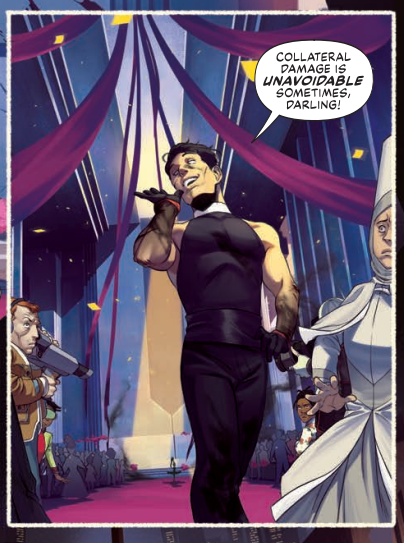
And the same for you V, can you give us a little background to you and your comic and illustration work?
VVG: I pretty much did comics-intensive illustration straight out of university up to now, since it turns out one of the things you can do with a BA in English is work in an unrelated field immediately. I think the first thing I ever illustrated was a story with Owen Johnson and Lizzie Boyle with Disconnected Press (at the time), and I’m still working with both of them now!
Since most of my art background is in oil painting, I’m primarily a cover artist, and when I’ve done interior art it’s had to have been standard pen & ink format for time reasons. Since it takes about 20-60 hours per page in fully-painted mode, you can imagine the timescale on a full issue of that isn’t something that works for most publishers.
VV, we’ve talked before about how you make your art in a slightly unusual fashion – creating roughs in a notebook and scanning them in, but then, with the roughs as a guide to where figures will be, you paint the backgrounds for every page and only finish the figure work once all the backgrounds are done.
Is that still the case or is it in a more traditional fashion now? What are the benefits for you? And is that why we have such lush and grandiose backdrops for the characters at times here?
VVG: That’s still pretty much the case! It’s easier to change a figure to fit a background than vice versa, and the backgrounds define the palette and lightsources for the figures, so it works out better in the long run if I finish those first. Although I do pencils for everything at the same time, so ideally there isn’t too much to change once the backgrounds are painted.
In terms of the so-called lushness, it’s easier for me to know how to render things in paint than in your normal pen & ink format, my brain doesn’t work the right way for two-tone art. I think as well since I can paint this stuff, and Rebellion gives me time in their production schedule to paint it, I should! Making work that’s nice to look at as much as it’s a narrative tool is important to me – since I’m not contributing to the writing part, the least I can do is go hard on the other half.
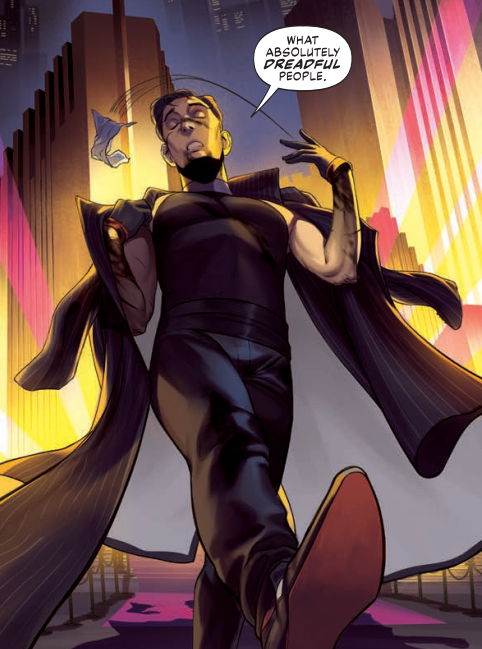
And as far as Devlin was concerned, what was the process of putting together Wedding Hells?
VVG: I started with a load of reference images for the characters and setting, so in this case a Pinterest’s worth of brutalist and art deco buildings, fashion illustrations, and copies of old issues. Then a little bit of concept work to see how the designs I had in mind looked in reality.
Once I had a vaguely cohesive look for everything I went to roughs, concentrating on flow across the page, use of space for effect (comedy and normal) and expression. Then a thumbnail colour rough to work out the pages as individual objects, and have them shift reactively over the story – so in this, we go from greens & blues in the introduction, to increasingly bright orange and pink as the action happens, then back down to a calmer blue and gold for the end.
Pencils after that, fairly roughly, painting the backgrounds straight over their pencils, and once they’re completed finalising the figure lineart. Figure colours get painted underneath those, to keep legibility, and finally I did a big layer-colour-detail pass to cohere all the visuals and add in extra bits that got missed out earlier in the process.
Sadly, all my concept & reference stuff was lost in a quote-unquote catastrophic motherboard incident, so page process is all I have, sorry about that!
Oh we’ve all been there V, thanks for sending over what you could!
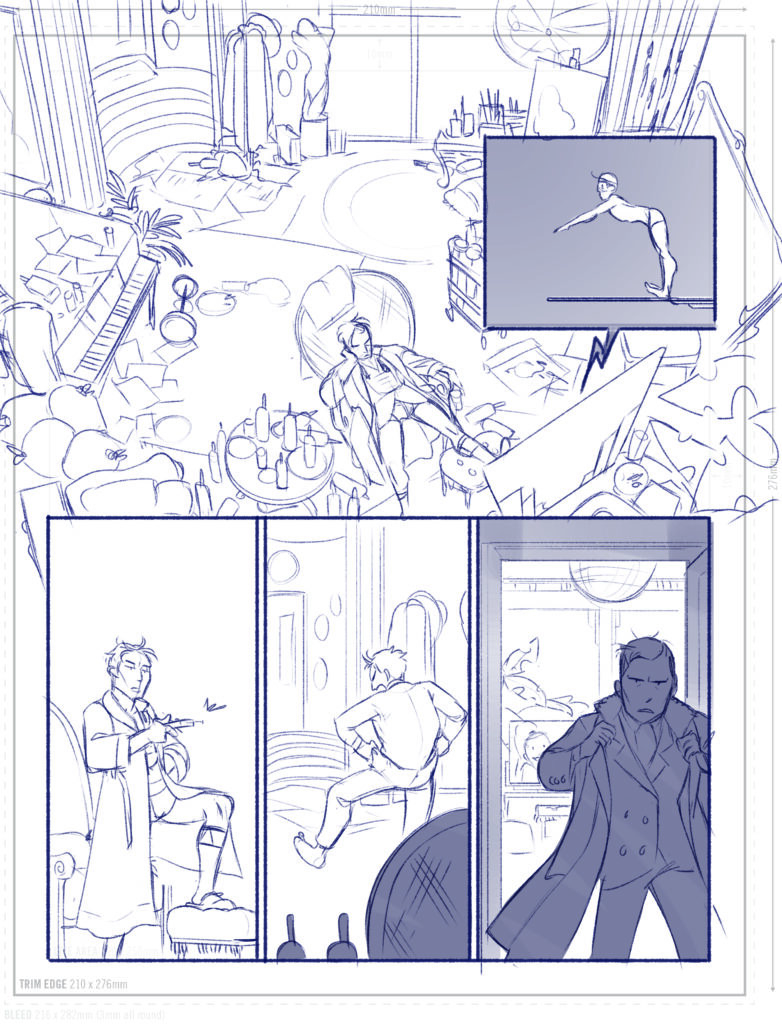
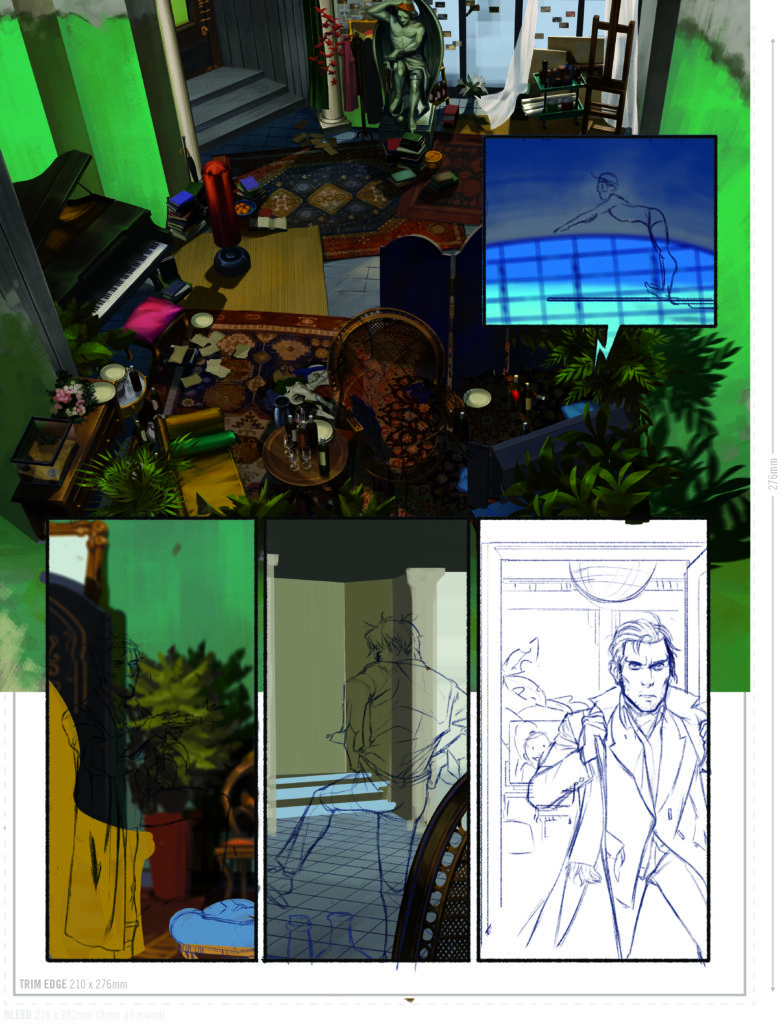
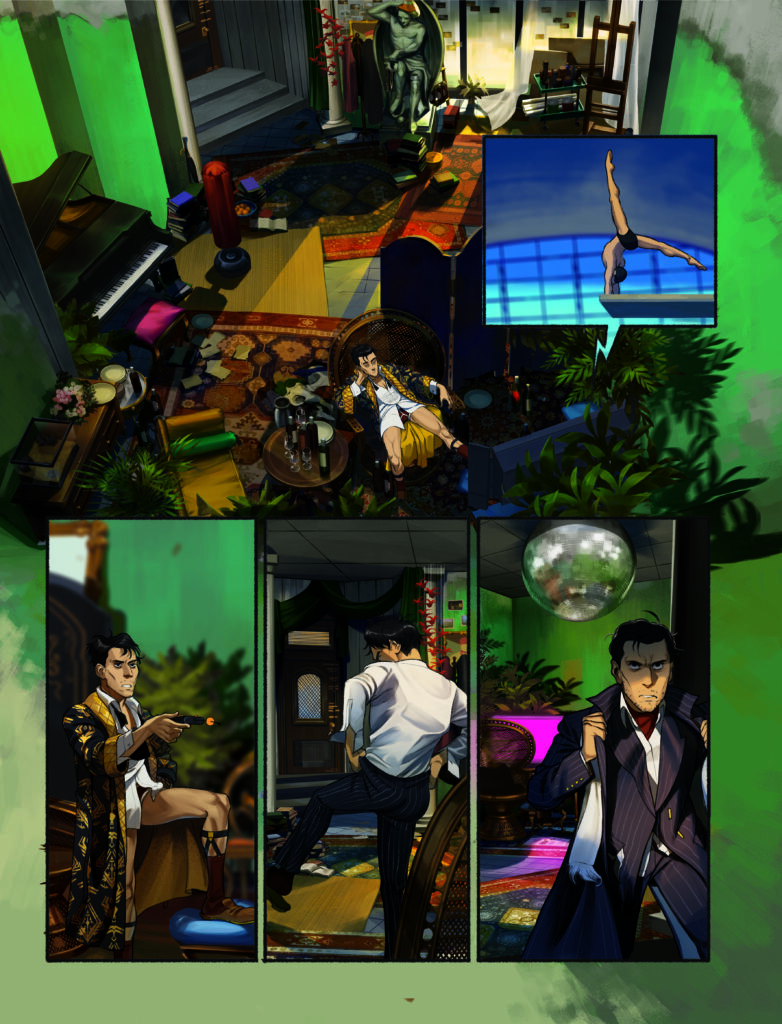
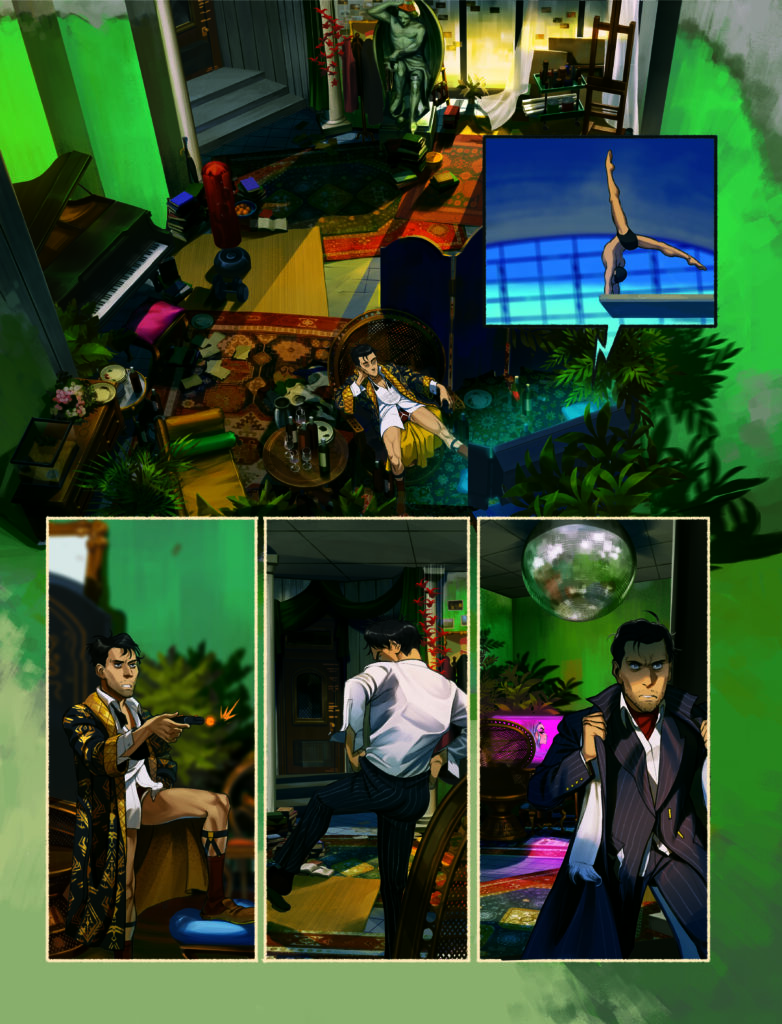
1, roughs. 2, adding the complete background and pencil figure work.
3, adding all figures and figure colour. 4, the final stage, getting it all just so!
From Devlin Waugh: Wedding Hells page 1.
>
Now, as we move to finish, what do you know or remember of 2000 AD, how did you first discover the comic, and what strips you specifically remember from the time you first discovered it?
OG: I got into 2000 AD through a friend lending me paperback collections, which continued as I was growing up (and we still lend each other books in much the same way), so my reading never actually lined up with what was currently available until very recently. My first experiences were mostly the really early Dredd classics – The Cursed Earth, Judge Cal, all the early epics. I don’t think I ever read any that were even in colour until I was about 17!
But the stuff that really got me – again, before my time, but I read it all in paperback with no sense of actual chronology – was Nemesis the Warlock. That weird spiky hostile energy drew me in completely, and I’ve never been the same since.
VVG: I think the first comic I ever bought was the Brian Bolland Dredd/Death collection (the one with the very understated ‘featuring Judge Death‘ subscript on the cover – sitcom guest star Death!) I was 12 and I read it on a 17-hour bus ride. I’ve pretty much collected any Dark Judges stuff that came out after that, the last one I remember buying was Wagner & Staples’ Dark Justice story. So in light of that I obviously remember the Grover-Bolland ‘Gaze into the fist of Dredd‘ strip.
Finally, what sort of things have we got to look forward to from you in the future? Whether that’s for 2000 AD or elsewhere?
VVG: I’ve almost finished work on the second volume of The Last Witch, an ‘unpleasant fairytale for younger readers’, the first volume of that came out in 2021 with Boom!. I’m also part of the backer rewards team for Early Bird, a far-future queer romance graphic novel that just went up for pre-order on Kickstarter. Other than that, the usual business continues, i.e. series covers with Titan and Black Market Narrative.
OG: My first graphic novel, Soup, comes out from Little Bee Books in the US next year, and also in some other places that I can’t talk about yet. That’s been taking a lot of my time and attention lately, but I’m starting to pitch other things around at the moment. So you can expect to see increasingly weird YA material coming out from me over the next few years, along with whatever short-form nonsense I can convince people to publish. (That one’s going pretty well so far. Keep an eye out for my name on anthology contributor lists.)
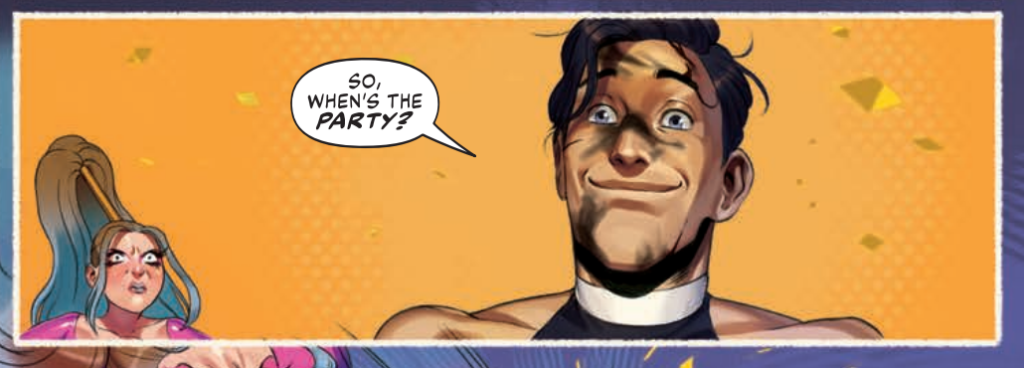
Thank you so much to both Oliver and V for what was a fascinating set of answers to those questions.
Their Devlin Waugh: Wedding Hells strip is a fabulous part of Mega-City Max, out on 19 July from comic shops and 2000 AD’s web shop. And of course, you can find everything Devlin Waugh, as created by John Smith and Sean Phillips, here.
You can find both Oliver and V online in plenty of places, here are just a few – Oliver’s website & Twitter, VV Glass’ website & Twitter.
Oliver’s first graphic novel, Soup, with Kelsi Jo Silva, comes out in 2024 from Little Bee Books. And you should definitely look out for Young Men in Love, the GLAAD award winning anthology from A Wave Blue World.
As for V’s work, you should be looking at all of it frankly (there’s a helpful list here), but take a particular look at the work on The Last Witch from Boom! Studios, written by Conor McCreery, that she’s been working on from 2019.
We shall leave you this time with the gorgeous full-size details to be found in VV Glass’ process work on Devlin Waugh: Wedding Hells, page 1, from first roughs to finished page, beginning with those roughs…

Full backgrounds added in, pencils scaled to backgrounds…

Figures and figure colours added…

V’s final pass at the art…

And the final printed page…
